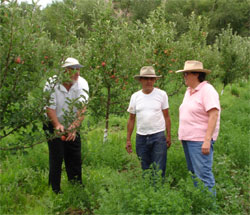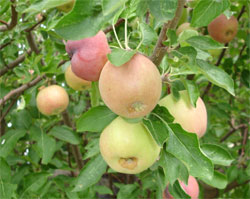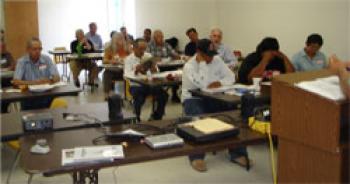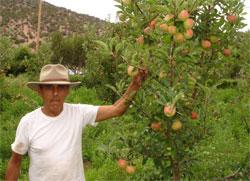Good Agricultural Practices
- CR-666: Organic Good Agricultural Practices for NM
Author: Nancy Flores, Extension Food Technology Specialist, Department of Extension Family and Consumer Sciences, New Mexico State University
- Western Sustainable Agriculture Research and Education Learning Center
Western SARE Grantee-Produced Info Product
Good Agricultural Practices (GAPs) Program for New Mexico

Talking GAPs in apple orchard with Fred Martinez and Ed Costanza; Velarde, NM
In response to the increase in fruit and vegetable associated food borne illnesses, the goal of this project is to provide educational materials to food producers and educational professionals associated with agriculture in order to reduce microbial risks in fruits and vegetables through good agricultural practices (GAPs) education. Seminars and display presentation have been done throughout the state.
- 2012 Chile Conference Conference Food Safety Presentation
"Attack of the Killer VEGIS !!" PowerPoint Presentation
GAP On-Farm Documents
GAP On-Farm Signs
Key Background Information

Apple tree in Velarde, NM August 2006
Between 1970 and 1997, the U.S. per capita consumption of fruits and vegetables increased 24% (577 lbs to 718 lbs per year)!
Food Borne Illnesses
As produce consumption has increased, scientists at the Centers for Disease Control and Prevention (CDC) in Atlanta, Georgia, noticed some important trend. From 1973 through 1998, there was a significant increase in the number of food borne disease outbreaks associated with fresh produce.
A summary of the food borne outbreaks from 1987 to present shows:
- The number of outbreaks associated with fresh produce steadily increased.
- The number of people affected more than doubled.
- A variety of fruits and vegetables were involved.
- Three-quarters (75.3%) of the outbreaks were related to domestically grown produce.
- Most of the outbreaks were caused by bacteria, especially Salmonella species and E. coli O157:H7.
Consumer Concerns
In response to consumer concerns, many retailers have recently announced programs requiring growers to have independent third-party inspections of farms to certify that fruits and vegetables are being grown, harvested, and packaged using good agricultural and management practices. These programs are developing rapidly and many growing and packing operations are already being inspected by companies, organizations, and agencies approved by retailers.
At least two large grocery chains - Safeway and Albertsons - require third-party inspections and certification for produce. Safeway requires it on what they have dubbed "high-risk" items, including strawberries and lettuce. Albertsons requires it for all produce.
Good Agricultural Practices (GAPs) Project
The goal of the Good Agricultural Practices (GAPs) Project is to reduce microbial risks in fruits and vegetables by developing a comprehensive extension and education program for growers and packers. The GAPs project has collaborators in 22 states throughout the nation (including New Mexico) and has created many educational materials to help promote the use of good agricultural practices on the farm. This project is funded by CSREES-USDA and US-FDA and the program is based at Cornell University.
Visit the Cornell University GAPs.
Closing Gaps in Food Safety

GAPs workshop for apple growers August 2006, Santa Fe County Fair Building
A growing number of producers realize that consumer concerns and retailer issues will intensify. These producers are now looking at ways to reduce microbial risks on the farm. These concerns and issues point to produce associated outbreaks that can adversely affect business:
- Strawberry industry lost an estimated $50 million in 1996 after mistakenly being indicated as the source of pathogens in an outbreak.
- Odwalla shareholder value dropped approximately 41% ($12.4 million) in six months after outbreak.
- Requirement of having third party inspections.
- Works against produce promotions campaigns.
- May result in unwanted legislation or regulation.
To help growers in their efforts, a group of universities are working together and have developed GAPs, or Good Agricultural Practices. The voluntary program provides growers with general guidelines that can be tailored to their own operation, says Dr. Bob Gravani, a Cornell University food scientist and GAPs project leader.
It is being funded by grants from the U.S. Department of Agriculture and the Food and Drug Administration. "We want to raise the bar and if there are any practices that are being done that could lead to contamination of fruits and vegetables with pathogens, we want to minimize those risks," Gravani says.
Food safety has changed over the years, and a whole host of microbes seem to be prompting food safety scares with increasing frequency--organisms such as Salmonella and E. coli O157:H7. Since 1987, three-quarters of those outbreaks were related to domestically grown produce, according to the Centers for Disease Control. "When there's a produce problem, it can certainly undermine all of the 5-A-Day programs that are working to increase fresh fruit and vegetable consumption," Gravani says. "It can be devastating from a lawsuit standpoint and just from business losses."
GAPs were developed with input from researchers representing a number of disciplines, including horticulture, vocational agriculture and food science. But more importantly, Gravani and his group sought grower input to determine whether the GAPs they were developing were even applicable or feasible on the farm. After all, every farm is different, and they wanted the GAPs to be flexible. "We put together focus groups of growers as well as academics and others with an interest in the area," Gravani says. "We gleaned from those things that farmers really thought would work." These concerns and issues point to produce associated outbreaks that can adversely affect business:
- Strawberry industry lost an estimated $50 million in 1996 after mistakenly being indicated as the source of pathogens in an outbreak.
- Odwalla shareholder value dropped approximately 41% ($12.4 million) in six months after outbreak.
- Requirement of having third party inspections.
- Works against produce promotions campaigns.
- May result in unwanted legislation or regulation.
Food Safety Begins on the Farm

Fred Martinez Velarde, NM August 2006
The result is the 28-page "Food Safety Begins on the Farm" guide. The easy to read publication provides ways to reduce microbial contamination in each aspect of production, from fertilizer and irrigation to picking and packing. It even has information on implementing a traceback system. Reading the publication is just the first step. To really benefit from the program, growers have to implement the guidelines, says Betsy Bihn, GAPs project coordinator. The GAPs program is designed to be a starting point and growers are free to develop their own food safety program that goes beyond the guidelines contained in the publication. The first step in this process is an extension-assisted on-the-farm grower self-assessment where you will:
- Review various production practices that you are using with fruits and vegetables.
- Assess your current management strengths and weaknesses related to minimizing microbial risks..
- Develop a comprehensive record keeping strategy that documents all farm actions that reduce microbial risks.
- Identify changes in farm management and production practices that can reduce the risk of microbial contamination.
- Develop action plans to improve the food safety of produce grown or packed on your farm.
Consequences and Costs
Although GAPs may seem overwhelming at first glance, Bihn says many growers are already following some of the practices. "It's not designed to be the straw that broke the camel's back," Bihn says. "In many cases, it doesn't require major farming modifications. They are actually things that the grower is doing already. And if you're not, they're probably things that you should be doing anyway."
Darbie Granberry, a University of Georgia Extension horticulturist and GAPs collaborator, says the program's perceived expense is a concern among producers. But it shouldn't be. "Growers are hesitant to do it because of the cost," Granberry says. "But they have to consider, 'what's the potential cost if I don't do it and I lose market share from potential liability?'"
A food safety program isn't free. It's requires a higher standard of management and it costs money. You have to spend money for maintenance and record keeping that you didn't spend before. Your buyers will most likely require a third-party audit by a firm specializing in food safety to verify compliance with Good Agricultural Practices. This third-party audit can be very expenses. The good news on this is that state departments of agriculture, with USDA's assistance, are developing an audit-based program that is helping the U.S. produce industry verify voluntary adherence to the U.S. Food and Drug Administration's Guide to Minimize Microbial Food Safety Hazards for Fresh Fruits and Vegetables.
Under the program, Federal-State Inspection Service (FSIS) personnel review a participating company's facility and agronomic practices, along with its documented procedures, to help determine if "Good Agricultural Practices" and "Good Handling Practices" are maintained. With this kind of audit-based verification putting a grower on a preferred vendor list and causing buyers to take note of the extra steps a grower has taken to help ensure a safe product, the belief is the benefit will more than absorb the costs. Growers utilizing GAPs with an audit-based verification system are placed on a preferred vendors list which recognizes that the grower has taken extra steps to ensure a safe product. So implementing GAPs is a win-win situation for everyone - growers, buyers, and consumers.
To learn more about GAPs for New Mexico Growers, contact: Nancy Flores, NMSU Extension Service at (575) 646-1179 or email at: naflores@nmsu.edu.
Visit the Cornell University GAPs for more information.
USDA Notice to Fruit and Vegetables Producers
Notice to Trade
Fresh Fruit and Vegetables Require Good Agricultural Practices (GAP) Verification
Several years ago the Agricultural Marketing Service, in cooperation with its State partners, developed the "USDA Federal-State Audit Verification Program for Good Agricultural Practices and Good Handling Practices."
USDA Requires GAPs
Notice to Trade
Fruit and Vegetable Vendor Food Defense Audit for Fresh Commodities
This notice is to inform vendors of USDA's Fruit and Vegetable Commodity Procurement Program of the intent to require annual food defense audits for fresh products beginning July 1, 2007.